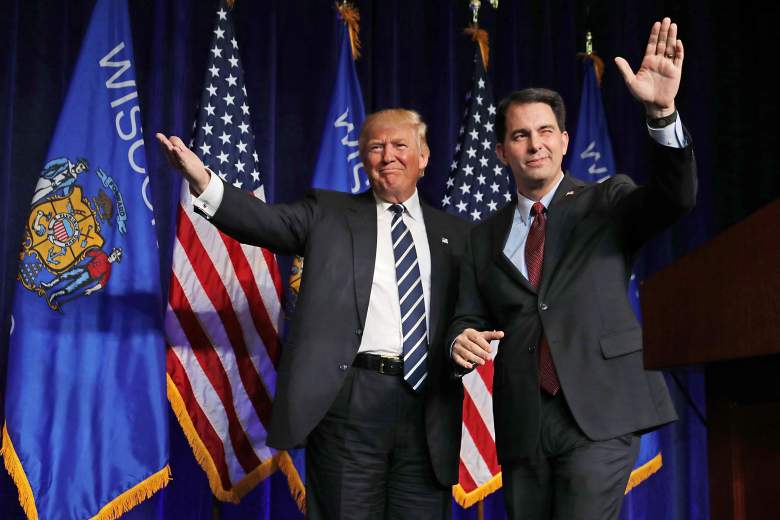
The news out of Wisconsin on Election Day night was dramatic: As of 12:45 EST, Donald Trump was winning Wisconsin by 49.1% to 45.7% with 84 percent of the vote in.
Wisconsin was a game changer, and within an hour or so, it was clear: Trump had carried the Midwestern state, which had not elected a Republican for president since 1984. He ended up winning by a slim 1%. And then Michigan fell. And Pennsylvania.
The rustbelt states were a rewriting of the electoral math, as rural whites without college degrees – a key part of the Democratic base – switched to Trump. Trump ended up with 279 electoral votes, as of the last counting. He needed 270. Fox News was first to call Wisconsin for Trump.
The polls were way off, including a poll by Marquette University Law School that is usually credible and showed him losing by 6%. Polling averages had Trump losing the state by at least 5% and pundits had written Wisconsin off.

The Republican Party of Wisconsin took this photo and shared it on Facebook during the campaign to show the crowd of people who attended a Trump rally in Wisconsin. (Getty)
Why did Trump do so well in Wisconsin?
He Rewrote the Wisconsin Map
Trump did well in western Wisconsin, in the areas that line the Mississippi River, places like LaCrosse. She ended up winning that city, but it was close, and he picked up the region.
These are rural and blue collar areas, full of the kind of voters that Trump had appealed to with his messages on trade, Obamacare premium increases (the impact of which was perhaps an under-reported story), jobs, and economic angst.
Overall Turnout Was Down; Hillary Didn’t Turn Out the Obama Coalition
Wisconsin turnout was at a 20-year low, election officials told Fox 6 Milwaukee, with 66% of voters showing up. Three thousand people voted in the U.S. Senate race but skipped the presidential, said the television station. Statewide turnout was about 70% for the previous two presidential elections, said the TV station.
The highest statewide turnout in Wisconsin was 73% in 1994 and 1960. Turnout was also down in the Democratic, diverse stronghold of Milwaukee County.
It was the first year that Voter ID was in place in Wisconsin.
It’s Run By Republicans
In some ways, Wisconsin was always fertile turf for Trump. First of all, it’s the home state of Reince Priebus, the chairman of the Republican National Committee, and of Paul Ryan, the House Speaker, whose support of Trump has been lukewarm but who did announce he voted for him.
Unlike some of its Midwestern neighbors, Wisconsin is really a purple state. That’s because it has a Republican governor, a Republican Attorney General, a Republican Legislature, one Republican senator (also up for re-election), and a conservative-oriented Supreme Court.
But the state went for President Barack Obama. Why? Because it was generally believed that presidential year turnout is better for Democrats. Of course, the Scott Walker machine has perfected a sharp get-out-the-vote machine (with his victories and recall) that is predicated on driving up turnout in Republican areas, primarily the suburban belt counties around Milwaukee. That’s how Walker has won, including in a recall that honed the GOP machine’s efforts more.
Previous polling had shown those areas – known as the “WOW Counties” – as being weaker for Trump for various reasons, among them the Never Trumpism of a prominent conservative talker, and the higher affluence and college-educated nature of that electorate (Trump fares well with rural, non college educated whites in the state). But Trump flipping western Wisconsin was critical.
The Walker machine kicked in gear. The big money tactics that have also elected conservative supreme court justices in the state worked here too.
Big Obamacare Premium Increases
An underreported story in the race: The fact the federal government announced big Obamacare premium increases on October 24. Some of the biggest were in battleground states like Pennsylvania and Minnesota.
Wisconsin is facing a 16% Obamacare premium increase, a fact that featured in many ads in the waning week of the campaign.
The Johnson Race
Here’s another wildcard, and it’s a big one: A lot of outside money flooded into Wisconsin to drive out the vote for Ron Johnson, the Republican senator who was being challenged by former U.S. Senator Russ Feingold, who used to hold the seat.
The money came in because Johnson’s seat is one that could determine control of the U.S. Senate. The Wisconsin State Journal called it a last-minute “ad barrage.” Johnson was also leading – by a wider margin than Trump. In the end, he won by a healthy margin. Some of the ads tied Feingold and Clinton together. Some of them focused on Obamacare premium increases.
Those GOTV efforts could very well have helped Trump win the White House.
The Demographics of the State & Economic Malaise
It’s surprising people didn’t think Wisconsin was more competitive for Trump all along in retrospect. Its demographics work for Trump, who fares better in largely white states. Wisconsin is 87.6% white. Just over 27 percent have a college degree. In contrast, Minnesota, which Trump almost won, has a higher percentage of its population with college degrees.
Furthermore, Wisconsinites have struggled with job growth that’s less than some of their neighbors and aren’t very happy in polls about the direction the state and country have been going in. A blue collar, largely white state with economic angst is the perfect petri dish for Trump.
Hillary Clinton Took the State for Granted
Clinton didn’t visit Wisconsin during the general election. At all. She took Wisconsin for granted. Trump came here several times, most recently to a rural area of the state: Eau Claire. He also appeared in populous Waukesha alongside the popular former Republican governor Tommy Thompson.